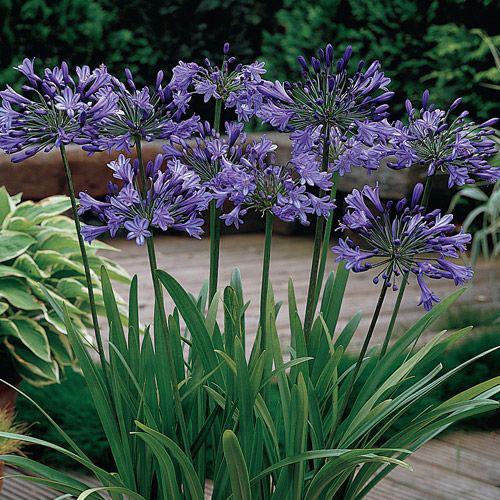Agapanthus Expanding Conditions: Soil, Sunshine, and Watering
Agapanthus Expanding Conditions: Soil, Sunshine, and Watering
Blog Article
Mastering the Art of Agapanthus Care: Crucial Steps for Healthy Development and Vibrant Flowers
In the realm of cultivation, the cultivation of agapanthus stands as a gratifying venture for those that look for to support these classy flowering plants. From picking the right variety to understanding pruning strategies, the trip in the direction of growing flourishing agapanthus plants is diverse and holds the crucial to opening the full potential of these organic treasures.

Choosing the Right Agapanthus Variety

When picking the ideal Agapanthus range for your yard, think about variables such as climate viability, flower color, and development behavior. Agapanthus, commonly understood as Lily of the Nile or African lily, can be found in a selection of colors varying from tones of blue and purple to white. Choose a flower shade that complements your existing garden palette to create an unified landscape. In addition, take into consideration the environment in your region to make sure the Agapanthus range you choose can prosper in your certain conditions. Some selections are much more tolerant of chilly temperature levels, while others choose warmer climates. Comprehending the development routine of different Agapanthus varieties is crucial for appropriate placement within your yard. Some selections have a clumping growth habit, perfect for boundaries or containers, while others have an even more spreading nature, ideal for ground cover or mass growings. By carefully assessing these variables, you can select the excellent Agapanthus selection to enhance the beauty of your garden.
Perfect Growing Conditions
Taking into consideration the ideal ecological requirements is essential for successful Agapanthus cultivation. Agapanthus plants are sensitive to cool temperature levels and ought to be secured from frost throughout winter months.
To guarantee healthy and balanced development and vibrant blooms, plant Agapanthus bulbs at a deepness of regarding 2-4 inches and room them 8-12 inches apart. Adding raw material, such as compost, to the dirt can improve drain and fertility, advertising durable root development. Mulching around the base of the plants aids keep wetness and subdues weed growth. Routine watering is crucial, particularly during the expanding season, to maintain the dirt consistently damp yet not saturated.
Watering and Fertilizing Tips
Keeping correct wetness degrees and supplying crucial nutrients are crucial elements in the treatment regimen for Agapanthus plants. When it pertains to watering Agapanthus, it is crucial to strike an equilibrium. If overwatered, these plants favor continually moist dirt but are vulnerable to root rot. During the growing period, water deeply when a week, ensuring the soil is well-draining to stop waterlogging. In hotter climates dig this or during periods of dry spell, more constant watering may be necessary to keep the dirt equally wet. However, decrease watering in the winter months to stop water logged conditions.
Feeding Agapanthus is vital for advertising healthy and balanced growth and prolific flowers. Use a well balanced plant food, such as a 10-10-10 formula, in the early spring as new development arises. Repeat this application every 6-8 weeks throughout the growing season. Avoid too much fertilization, as it can lead to lavish foliage at the expense of blossoms. Always follow the supplier's instructions for appropriate dilution and application methods. By complying with these watering and fertilizing suggestions, you can ensure your Agapanthus plants prosper and create vibrant, durable blooms.
Pruning Techniques for Agapanthus
Trimming Agapanthus plants at the proper times and with proper techniques is crucial for maintaining their health and wellness and promoting optimal development and flowering. The perfect time to prune Agapanthus is in late winter season or very early spring before new development emerges.
Deadheading spent blossoms can also redirect the plant's energy right into producing more blooms rather than establishing seeds. If you want to accumulate seeds for breeding, leave some blossoms to mature and dry on the plant.
Remember to utilize clean, sharp tools to make accurate cuts and reduce the danger of introducing conditions. Agapanthus. Routine trimming will certainly assist maintain your Agapanthus looking healthy and balanced and cool while making certain a bountiful display of stunning blooms
Taking Care Of Common Bugs and Illness
After guaranteeing correct pruning methods for Agapanthus, it is important to address typical bugs and diseases that can impact the health and vitality of these plants. Agapanthus plants are normally durable but can still drop sufferer to specific issues. One usual insect that influences Agapanthus is the Agapanthus gall midge. This small, orange fly lays its eggs in the foliage, leading to distorted development and flower buds that stop working to open up. To fight this pest, prune and damage any kind of afflicted plant components and consider using insecticidal soap.
Additionally, Agapanthus plants can suffer from root rot if they are planted in inadequately draining soil. why not find out more By being vigilant and taking prompt action versus bugs and diseases, you can assist your Agapanthus plants grow and generate vivid flowers. Agapanthus.

Conclusion
To conclude, grasping the art of agapanthus care entails picking the ideal variety, giving optimal planting conditions, appropriate watering and fertilizing, proper pruning techniques, and resolving typical parasites and illness. By adhering to these crucial steps, you can make certain healthy growth and lively blossoms for your agapanthus plants. Bear in mind to consistently keep track of and maintain your plants to advertise their general wellness and long life.
To make certain healthy and balanced development and lively blooms, plant Agapanthus Get More Information light bulbs at a depth of regarding 2-4 inches and area them 8-12 inches apart. By adhering to these watering and feeding pointers, you can ensure your Agapanthus plants grow and generate vibrant, long-lasting flowers.
One usual parasite that influences Agapanthus is the Agapanthus gall midget. Additionally, Agapanthus plants can experience from origin rot if they are planted in improperly draining soil. By adhering to these crucial actions, you can make certain healthy and balanced development and dynamic blooms for your agapanthus plants.
Report this page